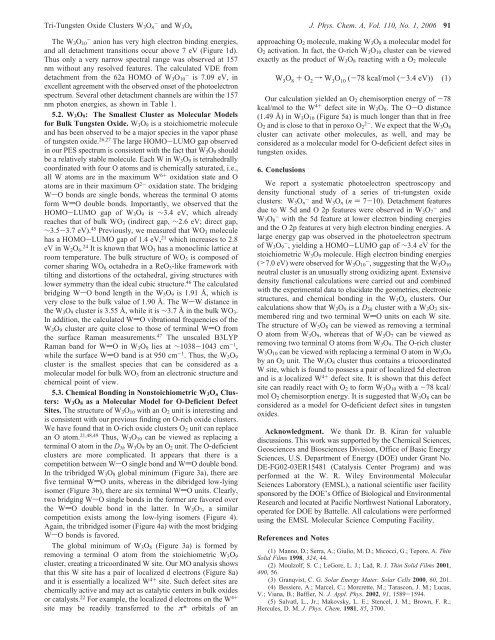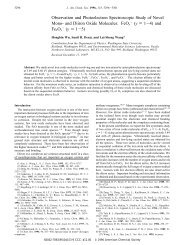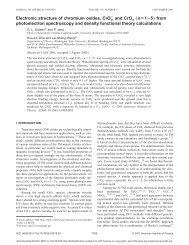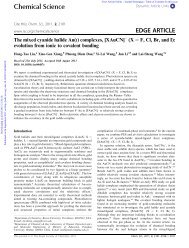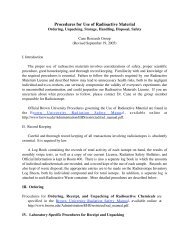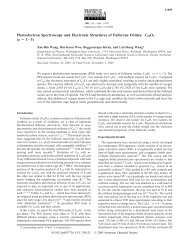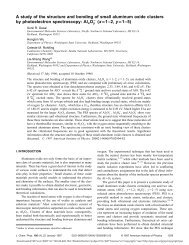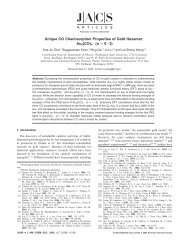On the Structure and Chemical Bonding of Tri-Tungsten Oxide ...
On the Structure and Chemical Bonding of Tri-Tungsten Oxide ...
On the Structure and Chemical Bonding of Tri-Tungsten Oxide ...
Create successful ePaper yourself
Turn your PDF publications into a flip-book with our unique Google optimized e-Paper software.
<strong>Tri</strong>-<strong>Tungsten</strong> <strong>Oxide</strong> Clusters W 3 O n - <strong>and</strong> W 3 O n J. Phys. Chem. A, Vol. 110, No. 1, 2006 91The W 3 O - 10 anion has very high electron binding energies,<strong>and</strong> all detachment transitions occur above 7 eV (Figure 1d).Thus only a very narrow spectral range was observed at 157nm without any resolved features. The calculated VDE fromdetachment from <strong>the</strong> 62a HOMO <strong>of</strong> W 3 O - 10 is 7.09 eV, inexcellent agreement with <strong>the</strong> observed onset <strong>of</strong> <strong>the</strong> photoelectronspectrum. Several o<strong>the</strong>r detachment channels are within <strong>the</strong> 157nm photon energies, as shown in Table 1.5.2. W 3 O 9 : The Smallest Cluster as Molecular Modelsfor Bulk <strong>Tungsten</strong> <strong>Oxide</strong>. W 3 O 9 is a stoichiometric molecule<strong>and</strong> has been observed to be a major species in <strong>the</strong> vapor phase<strong>of</strong> tungsten oxide. 26,27 The large HOMO-LUMO gap observedin our PES spectrum is consistent with <strong>the</strong> fact that W 3 O 9 shouldbe a relatively stable molecule. Each W in W 3 O 9 is tetrahedrallycoordinated with four O atoms <strong>and</strong> is chemically saturated, i.e.,all W atoms are in <strong>the</strong> maximum W 6+ oxidation state <strong>and</strong> Oatoms are in <strong>the</strong>ir maximum O 2- oxidation state. The bridgingWsO bonds are single bonds, whereas <strong>the</strong> terminal O atomsform WdO double bonds. Importantly, we observed that <strong>the</strong>HOMO-LUMO gap <strong>of</strong> W 3 O 9 is ∼3.4 eV, which alreadyreaches that <strong>of</strong> bulk WO 3 (indirect gap, ∼2.6 eV; direct gap,∼3.5-3.7 eV). 45 Previously, we measured that WO 3 moleculehas a HOMO-LUMO gap <strong>of</strong> 1.4 eV, 21 which increases to 2.8eV in W 2 O 6 . 24 It is known that WO 3 has a monoclinic lattice atroom temperature. The bulk structure <strong>of</strong> WO 3 is composed <strong>of</strong>corner sharing WO 6 octahedra in a ReO 3 -like framework withtilting <strong>and</strong> distortions <strong>of</strong> <strong>the</strong> octahedral, giving structures withlower symmetry than <strong>the</strong> ideal cubic structure. 46 The calculatedbridging WsO bond length in <strong>the</strong> W 3 O 9 is 1.91 Å, which isvery close to <strong>the</strong> bulk value <strong>of</strong> 1.90 Å. The WsW distance in<strong>the</strong> W 3 O 9 cluster is 3.55 Å, while it is ∼3.7 Å in <strong>the</strong> bulk WO 3 .In addition, <strong>the</strong> calculated WdO vibrational frequencies <strong>of</strong> <strong>the</strong>W 3 O 9 cluster are quite close to those <strong>of</strong> terminal WdO from<strong>the</strong> surface Raman measurements. 47 The unscaled B3LYPRaman b<strong>and</strong> for WdO inW 3 O 9 lies at ∼1038-1043 cm -1 ,while <strong>the</strong> surface WdO b<strong>and</strong> is at 950 cm -1 . Thus, <strong>the</strong> W 3 O 9cluster is <strong>the</strong> smallest species that can be considered as amolecular model for bulk WO 3 from an electronic structure <strong>and</strong>chemical point <strong>of</strong> view.5.3. <strong>Chemical</strong> <strong>Bonding</strong> in Nonstoichiometric W 3 O n Clusters:W 3 O 8 as a Molecular Model for O-Deficient DefectSites. The structure <strong>of</strong> W 3 O 10 with an O 2 unit is interesting <strong>and</strong>is consistent with our previous finding on O-rich oxide clusters.We have found that in O-rich oxide clusters O 2 unit can replacean O atom. 21,48,49 Thus, W 3 O 10 can be viewed as replacing aterminal O atom in <strong>the</strong> D 3h W 3 O 9 by an O 2 unit. The O-deficientclusters are more complicated. It appears that <strong>the</strong>re is acompetition between WsO single bond <strong>and</strong> WdO double bond.In <strong>the</strong> tribridged W 3 O 8 global minimum (Figure 3a), <strong>the</strong>re arefive terminal WdO units, whereas in <strong>the</strong> dibridged low-lyingisomer (Figure 3b), <strong>the</strong>re are six terminal WdO units. Clearly,two bridging WsO single bonds in <strong>the</strong> former are favored over<strong>the</strong> WdO double bond in <strong>the</strong> latter. In W 3 O 7 , a similarcompetition exists among <strong>the</strong> low-lying isomers (Figure 4).Again, <strong>the</strong> tribridged isomer (Figure 4a) with <strong>the</strong> most bridgingWsO bonds is favored.The global minimum <strong>of</strong> W 3 O 8 (Figure 3a) is formed byremoving a terminal O atom from <strong>the</strong> stoichiometric W 3 O 9cluster, creating a tricoordinated W site. Our MO analysis showsthat this W site has a pair <strong>of</strong> localized d electrons (Figure 8a)<strong>and</strong> it is essentially a localized W 4+ site. Such defect sites arechemically active <strong>and</strong> may act as catalytic centers in bulk oxidesor catalysts. 22 For example, <strong>the</strong> localized d electrons on <strong>the</strong> W 4+site may be readily transferred to <strong>the</strong> π* orbitals <strong>of</strong> anapproaching O 2 molecule, making W 3 O 8 a molecular model forO 2 activation. In fact, <strong>the</strong> O-rich W 3 O 10 cluster can be viewedexactly as <strong>the</strong> product <strong>of</strong> W 3 O 8 reacting with a O 2 moleculeW 3 O 8 + O 2 f W 3 O 10 (-78 kcal/mol (-3.4 eV)) (1)Our calculation yielded an O 2 chemisorption energy <strong>of</strong> -78kcal/mol to <strong>the</strong> W 4+ defect site in W 3 O 8 . The O-O distance(1.49 Å) in W 3 O 10 (Figure 5a) is much longer than that in freeO 2 <strong>and</strong> is close to that in peroxo O 2 2- . We expect that <strong>the</strong> W 3 O 8cluster can activate o<strong>the</strong>r molecules, as well, <strong>and</strong> may beconsidered as a molecular model for O-deficient defect sites intungsten oxides.6. ConclusionsWe report a systematic photoelectron spectroscopy <strong>and</strong>density functional study <strong>of</strong> a series <strong>of</strong> tri-tungsten oxideclusters: W 3 O - n <strong>and</strong> W 3 O n (n ) 7-10). Detachment featuresdue to W 5d <strong>and</strong> O 2p features were observed in W 3 O - 7 <strong>and</strong>W 3 O - 8 with <strong>the</strong> 5d feature at lower electron binding energies<strong>and</strong> <strong>the</strong> O 2p features at very high electron binding energies. Alarge energy gap was observed in <strong>the</strong> photoelectron spectrum<strong>of</strong> W 3 O - 9 , yielding a HOMO-LUMO gap <strong>of</strong> ∼3.4 eV for <strong>the</strong>stoichiometric W 3 O 9 molecule. High electron binding energies(>7.0 eV) were observed for W 3 O - 10 , suggesting that <strong>the</strong> W 3 O 10neutral cluster is an unusually strong oxidizing agent. Extensivedensity functional calculations were carried out <strong>and</strong> combinedwith <strong>the</strong> experimental data to elucidate <strong>the</strong> geometries, electronicstructures, <strong>and</strong> chemical bonding in <strong>the</strong> W 3 O n clusters. Ourcalculations show that W 3 O 9 is a D 3h cluster with a W 3 O 3 sixmemberedring <strong>and</strong> two terminal WdO units on each W site.The structure <strong>of</strong> W 3 O 8 can be viewed as removing a terminalO atom from W 3 O 9 , whereas that <strong>of</strong> W 3 O 7 can be viewed asremoving two terminal O atoms from W 3 O 9 . The O-rich clusterW 3 O 10 can be viewed with replacing a terminal O atom in W 3 O 9by an O 2 unit. The W 3 O 8 cluster thus contains a tricoordinatedW site, which is found to possess a pair <strong>of</strong> localized 5d electron<strong>and</strong> is a localized W 4+ defect site. It is shown that this defectsite can readily react with O 2 to form W 3 O 10 with a -78 kcal/mol O 2 chemisorption energy. It is suggested that W 3 O 8 can beconsidered as a model for O-deficient defect sites in tungstenoxides.Acknowledgment. We thank Dr. B. Kiran for valuablediscussions. This work was supported by <strong>the</strong> <strong>Chemical</strong> Sciences,Geosciences <strong>and</strong> Biosciences Division, Office <strong>of</strong> Basic EnergySciences, U.S. Department <strong>of</strong> Energy (DOE) under Grant No.DE-FG02-03ER15481 (Catalysis Center Program) <strong>and</strong> wasperformed at <strong>the</strong> W. R. Wiley Environmental MolecularSciences Laboratory (EMSL), a national scientific user facilitysponsored by <strong>the</strong> DOE’s Office <strong>of</strong> Biological <strong>and</strong> EnvironmentalResearch <strong>and</strong> located at Pacific Northwest National Laboratory,operated for DOE by Battelle. All calculations were performedusing <strong>the</strong> EMSL Molecular Science Computing Facility.References <strong>and</strong> Notes(1) Manno, D.; Serra, A.; Giulio, M. D.; Micocci, G.; Tepore, A. ThinSolid Films 1998, 324, 44.(2) Moulzolf, S. C.; LeGore, L. J.; Lad, R. J. Thin Solid Films 2001,400, 56.(3) Granqvist, C. G. Solar Energy Mater. Solar Cells 2000, 60, 201.(4) Bessiere, A.; Marcel, C.; Morcrette, M.; Tarascon, J. M.; Lucas,V.; Viana, B.; Baffier, N. J. Appl. Phys. 2002, 91, 1589-1594.(5) Salvatl, L., Jr.; Makovsky, L. E.; Stencel, J. M.; Brown, F. R.;Hercules, D. M. J. Phys. Chem. 1981, 85, 3700.


